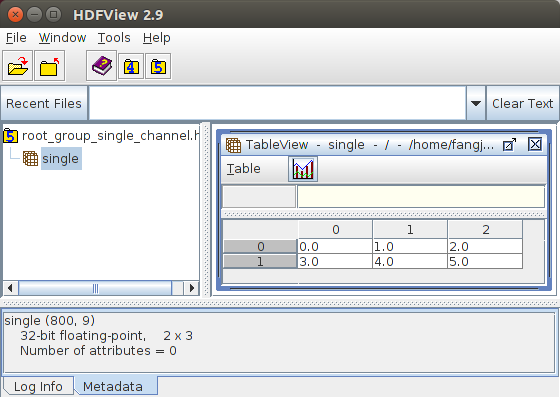Goal
This tutorial shows you:
- How to create a dataset?
- How to write a
cv::Mat to a dataset?
- How to read a
cv::Mat from a dataset?
- Note
- Currently, it supports only reading and writing cv::Mat and the matrix should be continuous in memory. Supports for other data types have not been implemented yet.
Source Code
The following code demonstrates writing a single channel matrix and a two-channel matrix to datasets and then reading them back.
You can download the code from here or find it in the file modules/hdf/samples/create_read_write_datasets.cpp of the opencv_contrib source code library.
#include <iostream>
static void write_root_group_single_channel()
{
String filename =
"root_group_single_channel.h5";
String dataset_name =
"/single";
h5io->dswrite(data, dataset_name);
h5io->dsread(expected, dataset_name);
double diff =
norm(data - expected);
h5io->close();
}
static void write_single_channel()
{
String filename =
"single_channel.h5";
String dataset_name = parent_name +
"/single";
if (!h5io->hlexists(parent_name)) h5io->grcreate(parent_name);
if (!h5io->hlexists(dataset_name)) h5io->dscreate(data.
rows, data.
cols, data.
type(), dataset_name);
h5io->dswrite(data, dataset_name);
h5io->dsread(expected, dataset_name);
double diff =
norm(data - expected);
h5io->close();
}
static void write_multiple_channels()
{
String filename =
"two_channels.h5";
String dataset_name = parent_name +
"/two_channels";
((
int*) data.
data)[i] = (
int)i;
if (!h5io->hlexists(parent_name)) h5io->grcreate(parent_name);
if (!h5io->hlexists(dataset_name)) h5io->dscreate(data.
rows, data.
cols, data.
type(), dataset_name);
h5io->dswrite(data, dataset_name);
h5io->dsread(expected, dataset_name);
double diff =
norm(data - expected);
h5io->close();
}
int main()
{
write_root_group_single_channel();
write_single_channel();
write_multiple_channels();
return 0;
}
Explanation
The first step for creating a dataset is to open the file
For the function write_root_group_single_channel(), since the dataset name is /single, which is inside the root group, we can use
h5io->dswrite(data, dataset_name);
to write the data directly to the dataset without the need of creating it beforehand. Because it is created inside cv::hdf::HDF5::dswrite() automatically.
- Warning
- This applies only to datasets that reside inside the root group.
Of course, we can create the dataset by ourselves:
if (!h5io->hlexists(parent_name)) h5io->grcreate(parent_name);
if (!h5io->hlexists(dataset_name)) h5io->dscreate(data.
rows, data.
cols, data.
type(), dataset_name);
To read data from a dataset, we use
Mat expected;
h5io->dsread(expected, dataset_name);
by specifying the name of the dataset.
We can check that the data read out is exactly the data written before by using
double diff =
norm(data - expected);
Results
Figure 1 shows the result visualized using the tool HDFView for the file root_group_single_channel. The results of matrices for datasets that are not the direct children of the root group are given in Figure 2 and Figure 3, respectively.

Figure 1: Result for writing a single channel matrix to a dataset inside the root group

Figure 2: Result for writing a single channel matrix to a dataset not in the root group

Figure 3: Result for writing a two-channel matrix to a dataset not in the root group





 1.8.12
1.8.12